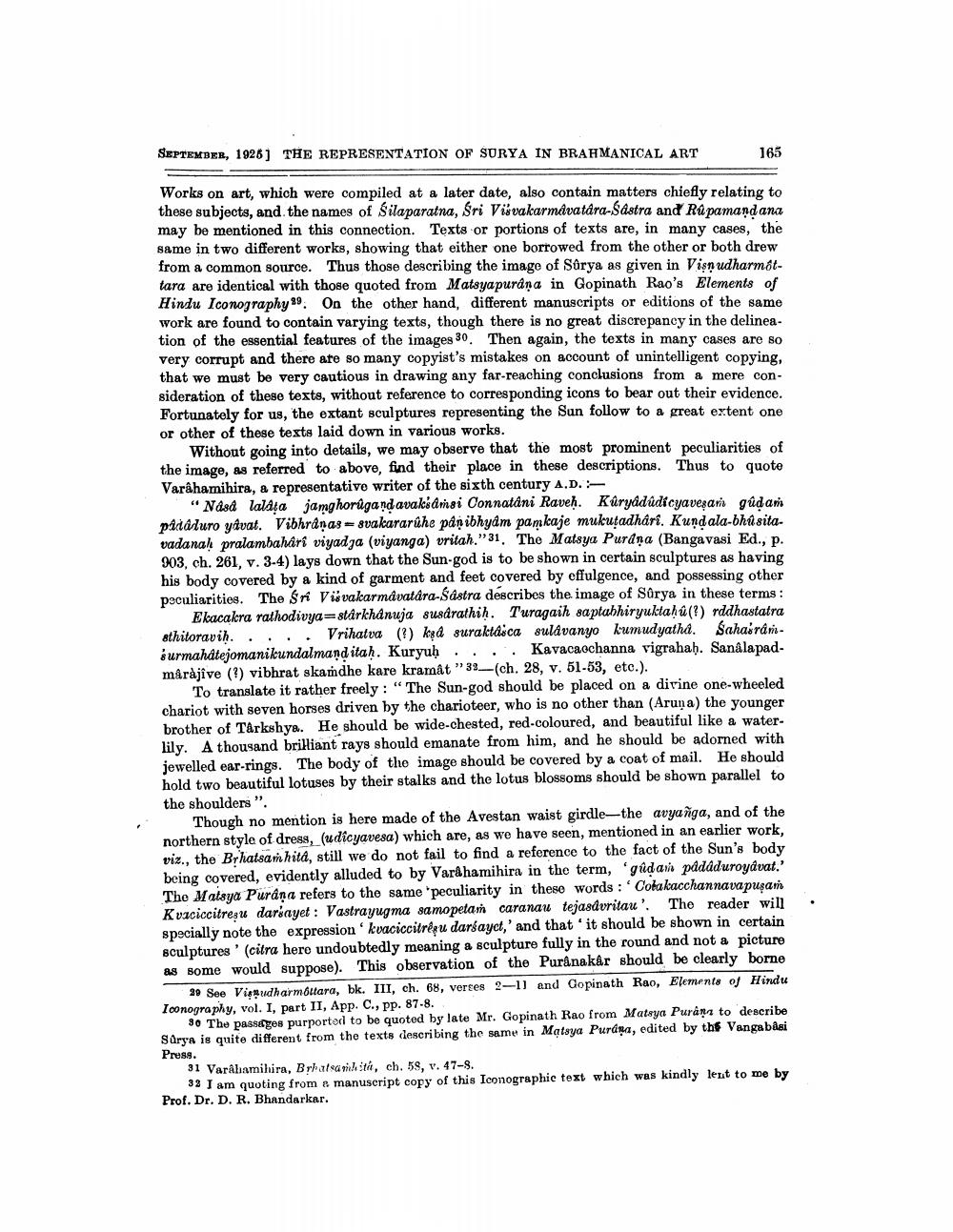________________
SEPTEMBER, 1926) THE REPRESENTATION OF SURYA IN BRAHMANICAL ART
165
Works on art, which were compiled at a later date, also contain matters chiefly relating to these subjects, and the names of Silaparatna, Sri Višvakarmavatara-Sastra and Rů pamandant may be mentioned in this connection. Texts or portions of texts are, in many cases, the same in two different works, showing that either one borrowed from the other or both drew from a common source. Thus those describing the image of Sürya as given in Vişnudharmottara are identical with those quoted from Matsyapurana in Gopinath Rao's Elements of Hindu Iconography 39. On the other hand, different manuscripts or editions of the same work are found to contain varying texts, though there is no great discrepancy in the delineation of the essential features of the images 30. Then again, the texts in many cases are so very corrupt and there are so many copyist's mistakes on account of unintelligent copying, that we must be very cautious in drawing any far-reaching conclusions from a mere consideration of these texts, without reference to corresponding icons to bear out their evidence. Fortunately for us, the extant sculptures representing the Sun follow to a great extent one or other of these texts laid down in various works.
Without going into details, we may observe that the most prominent peculiarities of the image, as referred to above, find their place in these descriptions. Thus to quote Varahamihira, a representative writer of the sixth century A.D.
"Nasa lalata jamghorúgandavakšamsi Connatäni Raveh. Kúryádůdícyaveşarı güdam picaduro ydvat. Vibhraņas - svakararühe päņibhyam pamkaje mukutadhari. Kundala-bha sitavadanah pralambahari viyadga (viyanga) vritah.”31. The Matsya Purana (Bangavasi Ed., p. 903, ch. 261, v. 3-4) lays down that the Sun.god is to be shown in certain sculptures as having his body covered by a kind of garment and feet covered by effulgence, and possessing other peculiarities. The Sri Visvalarmavatara-Sastra describes the image of Sûrya in these terms:
Ekacalera rathodivya=starkhanuja susdrathih. T'uragaih saptabhiryuktah (?) rddhastatra sthitoravih..... Vrihatva (?) kpd suraktasca sulavanyo kumudyatha. Sahasransurmahatejomanikundalmand itah. Kuryuh...: Kavacaochanna vigrahah. Sanalapadmârajive (?) vibhrat skaṁdhe kare kramât ”32—(ch. 28, v. 51-53, etc.).
To translate it rather freely : “The Sun-god should be placed on a dirine one-wheeled chariot with seven horses driven by the charioteer, who is no other than (Aruna) the younger brother of Tarkshya. He should be wide-chested, red-coloured, and beautiful like a waterlily. A thousand brilliant rays should emanate from him, and he should be adorned with jewelled ear-rings. The body of the image should be covered by a coat of mail. He should hold two beautiful lotuses by their stalks and the lotus blossoms should be shown parallel to the shoulders ".
Though no mention is here made of the Avestan waist girdle—the avyañga, and of the northern style of dress, (udicyavesa) which are, as we have seen, mentioned in an earlier work, viz., the Brhatsamhita, still we do not fail to find a reference to the fact of the Sun's body being covered, evidently alluded to by Varahamihira in the term, gådan pådaduroyávat.' The Matsya Purana refers to the same peculiarity in these words : Cobakacchannavapusan Kvaciccitresu dar ayet: Vastrayugma samopetan caranau tejasduritau'. The reader will specially note the expression kevaciccitrêru darśayct,' and that it should be shown in certain sculptures' (citra here undoubtedly meaning a sculpture fully in the round and not a picture as some would suppose). This observation of the Puranakâr should be clearly borne
20 See Vishudharmóttara, bk. III, ch. 68, verses 2-11 and Gopinath Rao, Elements of Hindu Iconography, vol. I, part II, App. C., pp. 87-8.
30 The passages purported to be quoted by late Mr. Gopinath Rao from Matsya Puran to describe Sarya is quite different from the texts describing the same in Matsya Purára, edited by the Vangabasi Press.
31 Varahamihira, Brhatsamhith, ch. 59, v. 47-S.
33 I am quoting from & manuscript copy of this Iconographic text which was kindly lent to me by Prof. Dr. D. R. Bhandarkar.




